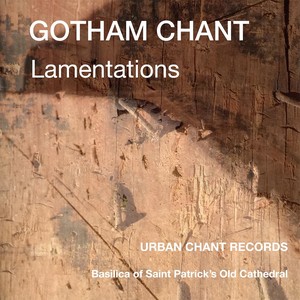
- 歌曲
- 时长
-
Lamentation 1
-
Lamentation 2
-
Lamentation 3
-
Lamentation 4
-
Lamentation 5
-
Lamentation 6
-
Lamentation 7
-
Lamentation 8
-
Lamentation 9
简介
Recorded at the Basilica of St. Patrick’s Old Cathedral, New York City Produced by Jared Lamenzo and Joshua South Recorded by Malcolm Addey Mastered by Nate Wood at Kerseboom Mastering Members of the Basilica Schola: Lianne Coble, John Des Marais, Silvie Jensen, Joshua South, Peter Stewart, John Tiranno Tracks: Tenebrae factae sunt: Gaspar Von Weerbeke (c.1445 - C.1516) Lamentation 1: Holy Thursday Lamentation 2: Holy Thursday Lamentation 3: Holy Thursday Sederunt in terra: Elzéar Genet "Carpentras" (c.1470–1548) Lamentation 4: Good Friday Lamentation 5: Good Friday Lamentation 6: Good Friday O vos omnes: Giovanni Matteo Asola (c. 1540-1609) Lamentation 7: Holy Saturday Lamentation 8: Holy Saturday Lamentation 9: Holy Saturday Recordare Domine: Elzéar Genet "Carpentras" (c.1470–1548) Notes: There is a certain distopian, or kakotopian, flavor to our popular entertainment today. From zombies to apocalyptic movies, it gets dark. However, this isn’t new, nor is human nature. The prophetic messages of Jeremiah speak to this sentiment, but at the same time, offer a hopeful vision that leaves the immediate, localized chaos behind. The office of Tenebrae (Latin for “shadows” or “darkness”) has changed over the centuries, originally celebrated as Matins and Lauds over three days (Holy Thursday, Good Friday, and Holy Saturday), but later anticipated the evening before. At the liturgy, fifteen candles are extinguished, one by one, and the congregation leaves in total silence after a loud strepitus (usually the closing of a book, meant to evoke the earthquake said to happen at the moment of death). This album does not contain all of the music or text that would occur as part of the office, but it does contain the imagery that makes the office so powerful. The chants are based on an English setting created by Monsignor Richard B. Curtain (1916-2002), who was professor of church music at St. Joseph’s Seminary in Yonkers, NY from 1946-1966. It contains both Gregorian and Mozarabic chant. Mozarabic chant is the liturgical plainchant of the Mozarabic rite, which continues to be used in locations in Spain, especially Toledo. Before each Lamentation, a Hebrew letter is intoned; the more florid melodies are the Mozarabic chant. To put the text in deeper relief, we added drones to some of the chant. Some of our favorite polyphonic settings of the Lamentations cannot be found in a quality recording; there are four in this recording. We sing these works at various points during Lent and Holy Week. Of the same epoch as Josquin des Prez, Gaspar van Weerbecke (c.1445-1516) is an under-appreciated composer of the Franco-Flemish school. He united the contemporary Italian style with the older Burgundian style of Dufay in a unique way. The text is from the Passion: Tenebrae factae sunt, O bone Jesu, dum te crucifixissent Judaei, et circa horam nonam exclamasti voce magna: Deus, Deus meus, ut quid dereliquisti me. Et inclinato capite emisisti spiritum. Cum ergo accepisses acetum, dixisti: consummatum est. Darkness fell, gentle Jesus, when the Jews crucified you and about the ninth hour you cried with a loud voice: My God, my God, why hast thou forsaken me? And you bowed your head, and the spirit departed from you. When, therefore, you had received the vinegar, you said: it is finished. One may wonder about Weerbecke’s choice of major C triads to set portions of this text. However, he was working before major and minor tonality; we listeners are acculturated into hearing minor keys as “sad” and major keys as “happy” in grade school. This is not the case with this music; it was written for sophisticated audiences with a developed understanding of the ways in which music operates in theory and in spirit. It also operates like that today, given a listening in the proper context. We have two pieces of polyphony by Elzéar Genet (c. 1470-c. 1548), better known as Carpentras (a town in southwestern France near Avignon). Both works come from his setting of the Lamentations of Jeremiah, which was treasured by the Papal Choir and sung in the Sistine Chapel throughout the 16th century. His music uses imitation and homophony to accentuate the text in an elegant, elevated manner. He worked for three Popes: Julius II, Medici Pope Leo X (an enthusiastic patron of the arts), and Clement VII, to whom he gave the manuscript of these works. The first piece is Sederunt in terra (Lamentations, ii, 10): Sederunt in terra, conticuerunt senes filiae Sion: consperserunt cinere capita sua, filiae Jerusalem, filiae Jerusalem, accinctae sunt ciliciis, abjecerunt in terram capita sua virgines Juda. The elders of the daughter of Zion sat upon the ground and were silent: they scattered ashes on their heads; the daughters of Jerusalem have wrapped themselves in sackcloth; the daughters of Judah have bowed their heads to the ground. The use of repetition, and the final melismas, portray the sorrow of the text. The second motet (Lamentations v, i) uses imitation, suspensions, and an unusual leap of a fourth at "opprobrium" (disgrace) for its text: Recordare, Domine, quid acciderit nobis, intuere et respice opprobrium nostrum. Remember, O Lord, what has befallen us; behold, and see our disgrace. O vos omnes (Lamentations i, 12) was written by Giovanni Matteo Asola (c. 1540-1609). Much of Asola’s life was spent in Venice, though he writes more like a member of the Roman school. This work was published in a collection in 1588, and has a sense of poignancy due to its refined melodic contour and linear elegance. The motif throughout is of a sigh (the half step at the beginning): O vos ornes qui transitis per viam, attendite et videte, si est dolor sicut dolor meus. All you who pass by, stop and see if you have seen any sorrow like my sorrow.





